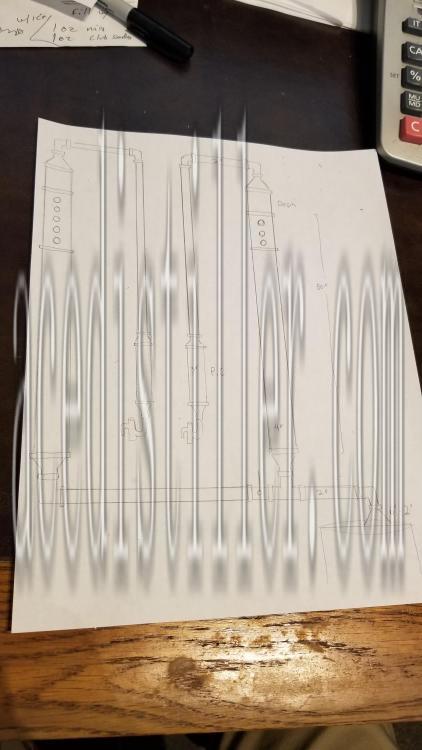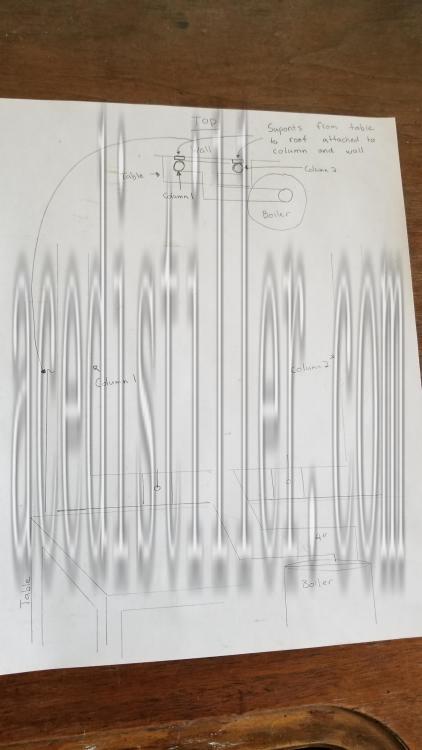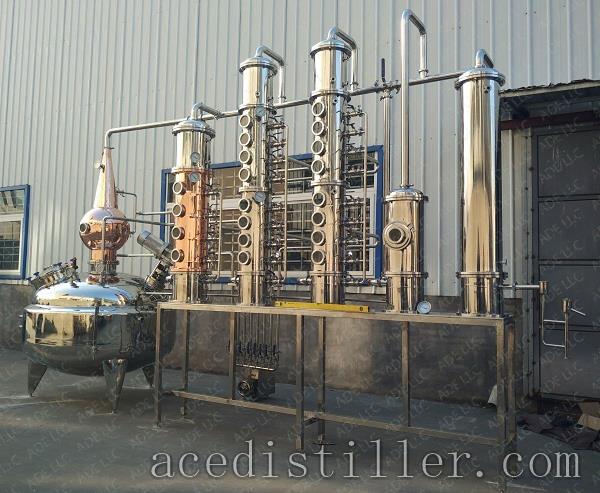-
Running Two Columns Using only One Pot
Posted by adamovd on September 3, 2019 at 8:16 pmThis is my current vodka set up. It’s a 4″ column. Bottom sections are packed.

It works great, but runs very slowly. At some point I will need to increase the output, and my idea is to build a second column like in the picture below.

Does anyone forsee any problems or input with this design? Or have any experience running two columns from a single pot?
fijispirits replied 5 years, 3 months ago 4 Members · 24 Replies -
24 Replies
-
What size is your pot and how long does your run currently take? Are you running 190 proof with this? How many BTUs of heat are you putting into it? What is the size of your current condenser? If the pot is 55 to 105 gallons you need a 6″ column on it for faster run times. You need around 1,000 BTUs of heat per gallon of mash for a good fast heat up time. You need at least 500 BTUs per gallon of mash.
I have never seen someone run 2 columns in the way that you want to do it. You may have issues with the column at the end of the line because your vapor path and your condensate return are the same line, or you may not. One 6″ column would be a much better option.
What is the condenser on the right for?
-
@Southernhighlander Condenser on the right is for my larger stripping still (your bain marie). I am hitting 190. Pot is 55 gal filled with low wines. It has 3 elements and gets up to temp in 45 min. I run it at 21% power once it gets up to temp, and I get a little over a proof gallon an hour. I’ve already maxed my ceiling height, so I can’t go any higher. I’m not sure how to make a 6″ column work.
-
If the bottom horizontal pipe remained 4″ instead of 2″ and was slightly angled towards the pot would it be better?
-
Yes, but I think that 3″ would be large enough.
-
Thanks for your input Paul! I’m still tweaking the design.
-
Adamovd. I run a 4” myself but we are able to pull off 7.5 liters an hour average over a spirit run and 25l per hour on a stripping run. Actual take off varies between 9l and 5l per hour.
The similarities between our setups are are as follows:
– I have to do a stripping run then a second spirit run
– 3 element input (16500w)
– 140l boiler
– 4” column around 6.5’ or 2m tall of rectification.
– similar take off proof (93.5%)
The operative differences that allow me to go faster than you are:
– 12” reflux condenser
– extra product precondenser
– my boiler is wider so it provides more surface area to create vapor without cavitation causing foaming and flooding
– I use 11 pro-cap plates which allow much faster vapor speeds and more efficient rectification per plate than perf or bubble cap plates. I found packed sections to be way too slow even if they gave more theoretical rectification. The gains in proof came thru massive loss of production.
– Im able to run at 9000 watts input power consistently
I’ve tried many different configurations to speed the system up and based on my experiments here’s what I think you could do to your cost effectively to increase production.
– if you can’t move to procap plates then change up your column packing to some random column packing like metal cascade mini rings or Intalox ultra or maybe even a 12mm helipack. These will allow higher vapor flow rates and more efficient rectification per surface area than scrubbies or ceramic packing. Your HETP will increase but so will your speed.
– mixing plates and packing in the same refluxed column is a speed killer. At the very least swap the plates to the bottom to see if that helps
– if you need to do two columns then run a sequential two column design not a parallel two column you’ll be a bit more limited in overall flow POTENTIAL but you’ll gain it back in quality and real world speed once you get it dialed in
– you MIGHT be able to do the “two sequential columns” thing where the first column was procaps with a big reflux condenser then the second was packing. Not sure how that would work but I think they need similar flows.
– add 10-12” of empty open pipe at the bottom of your column or decrease boiler fill level. This gives expansion space for foam and bubbles to form and collapse when you push the power up.
Honestly i get your thought process here. I do. I don’t think it’s the most cost effective solution. I think the columns would need to be evenly spaced from the boiler output at a minimum. If not it’ll get all wonky and will probably make shit worse
I think the most cost effective and cheapest low risk option to increase production would be to change out your entire column to Intalox ultra random packing and give it a little head space in between the boiler and the bottom of the packing. Maybe just under fill the boiler by 8-10” SERIOUSLY THESE TWO THINGS SHOULD ALMOST DOUBLE YOUR FLOW RATE
After that the real solution would be switching up to a 6” procap column and reflux condenser as your most simple and flexible option. That should get you to 10-12 liters an hour. I’m not kidding about procaps, they are legendary
Give Larry at still dragon a call. He’s pretty switched on with these sorts of things. And he’ll even tell you what’s good if he can’t sell something to you.
-
Fiji,
So you are saying that you 35 gallon still will put out 25 liters per hr during a stripping run with 16,500 watts of heat. What is the proof of your low wines? Also are you saying that with 11 plates you are producing 7.5liters per hour of 190 proof or above with 16,500 watts of power in a 35 gallon still?
-
Adam,
If it were me, I would just put both 4″ columns on top of the pot that way they will feed evenly. If you need to isolate one just put a 4″ valve on a riser so that you are only running one column, I have the 4″ sanitary valves in stock. As far as plates go, concerning through put etc, ours are as good as any out there including procap plates. If you need a 6″ column let me know and I will give you a good discount.
-
@FijiSpirits Thanks so much! Sounds like we are running pretty similar systems, but you have a lot more experience with it. Everything you said is super helpful. You are right that what is slowing the current column down is that it floods if I put too much heat to it. I can run a lot faster when making a gin base that doesn’t have to stay above 190P. I’ll play around with what you’ve suggested. Maybe I can gain the needed speed with just the one 4″ column for now. I’m not familiar with what a sequential still design is though.
@Southernhighlander I would like to just come off the top of boiler, but I’m also trying to figure out a safe way to support all this weight. I also switch the column out to make non neutral spirits in the same boiler. So the idea is to branch it off and have both neutral columns set up permanent. Supported by a table and attached to the wall. Then I can disconnect it and attach a whiskey head easily. I’d love to just buy a 6″ column from you, but that probably won’t happen any time soon.
Here’s a revised sketch. Do you think the larger piping under the columns will help provide “headspace” and combat flooding issues?

The original plan was not to be making so much or really any vodka or gin, but its paying the rent for now and I’m trying to work with what I’ve got. Thanks again.
-
Yes to all except it’s a 37 gallon actual charge and my proof. As above, typically I average 91-93.5%abv. We normally don’t run full heat. Max seems to be around 14500w input. Proof on strip run is ~40%. If the run is too foamy speed slows but we are managing that pretty well these days. These are sugar wash.
Note that we only use that much power during stripping in pot still mode for spirit runs we are at around 9000w max power is reserved for heat up cycle only
Normally we try for for three strips a 8 hour shift. Usually about 2:40 per run from start to finish. Foaming will cut us to two strips.
-
Adamovd. When I say sequential I mean 2 separate columns plumbed together. First one feeds the bottom of the second. If you had 10 plates per column you’d have a 20 plate still. You need 2 reflux condensers tho.
You can get at least 50% more flow out of that thing pretty easy. Just dick around with the packing and configuration a bit and see what works. Some perf plates have holes that are too small. Unfiltered wash can cause blockages, and Standard bubble caps are a dead end if you want more speed tho.
-
@FijiSpirits I figured that’s what you meant, but trying to do a self build on something like that and expecting it to work right away is probably a little over ambitious. I don’t really understand how the transfer of vapor works between the two columns. The plates are perf plates and the packing is just copper scrubbers, just to give you more info. The goal is to get as close to doubling my output speed as possible. If I can do that, I can do one spirit run to one stripping run and eliminate a major bottle neck in production. I’ll play with the configuration and start researching better packing materials, and see where it puts me first. Hopefully you’ve saved me a ton of time and effort.
-
It’s be real easy to put those plates on the bottom and loosen up those scrubbies.
Check out the packings I list above. I’m working on a continuous stripper just now and those seemed to float to the top as good candidates for speed. Particularly intalox ultra. Second choice would be the metal cascade mini rings which will be cheaper. On sizing my thoughts are to keep it around 1/2” but I’ve yet to talk with anyone knowledgeable about a 4” application.
-
Adam this is bad advice.
If you run vapor through one 20 plate column then you get 100% plate functionality. If you run vapor through two 10 plate columns sequentially then the last column in line has the functionality of 10 plates and the 1st column in line only has the functionality of 5 plates. If you have 3 columns in line then the 1st column only has 25% plate functionality. There is a way to make them function with 100% plate functionality even with 3 or 4 separate columns. Can you guess how?
-
@Southernhighlander I am obviously no expert in still dynamics. I don’t even understand why you would have such a huge drop in efficiency between columns. My best guess would be if the column was in a vacuum, or if you had a ‘thumper’ type reservoir under each column. I’d love to know though.
-
Based on the OP’s pic, there is no room for additional column height.
There is a drop in efficiency because with multiple columns, it is typical to return previously distilled alcohol back to the kettle. This makes it difficult to maintain purity and also hold proof at that purity.
A single column would be optimal. But sometimes a single with the requisite amount of plates for a vodka snob’s vodka just won’t fit
-
That’s true and when there is no room for additional column height we split the columns, however when we split the columns, all of our columns, even if there are 4 of them, do not have a drop in efficiency. If we have 4 columns in line on our stills that have 5 plates each they will put out the same as a single 20 plate.
Also the OP wants to increase speed. Adding columns in a sequential manner will decrease speed and decrees efficiency over a single column with the same number of plates unless they are modified in the way that we do it, so as I said it’s bad advice.
-
Adam,
I don’t want to say how on here because my competitors will use the info to modify their equipment. If you or any other distiller on here wants to know just email me privately.
Thanks
Paul
-
Smaug,
Giving sequential columns full functionality is not hard to figure out. If you spend a little time on the problem I’m sure that you can figure it out on your own.
-
I’d guess that you’d add a reflux condenser at the top of each. Product processes thru ten plates and passes a reflux. Vapor goes into second column purified thru ten plates then proceeds up ten more plates and a reflux condenser. Ideally the downcomings from the bottom plate second column would be pumped up to top plate first column.
My question is… what happens if you let those second column bottoms accumulate like a thumper? Does it slow everything down, or does it make no real difference assuming it has enough room to be reheated by incoming vapor?
I would think that if you had enough space for the bottoms to accumulate and have the vapor run thru them that they would eventually balance. That begs the question as to if you even need the first reflux condenser then?
Does anyone have any actual daily production experience with this?
I’m weak on fluid dynamics, my engineering degree is in construction engineering and from a country that no longer exists. I wish I had taken more chemistry!!
-
I dropped out of school in the 9th grade.
I collected my data at my equipment testing lab years ago. Once I saw the data, I figure out the reason why the column functionality decreased. Once I figured that out, it was easy to give multiple columns the same functionality as one vertical column. Since I figured that out, I have sold dozens of vodka stills with multiple columns similar to the one below.
You are a smart guy. You are correct about the pumps. When running 3 columns the first column in lines dephleg has very little to no flow.
I’ve tried lots of different things including designing the bases of bubble plate columns to where the incoming vapor had to go through 6″ of column condensate. It did increase proof but there were draw backs.
A country that no long exists? Most likely Rhodesia since your written English is so good, but maybe Yugoslavia, the Soviet Union (East Germany) or possibly Czechoslovakia, but what you said is something that a Czech or Slovak would never say.

-
Steve,
A thumper at the base of the column would be very similar to an added plate. The extra liquid volume would give any alchohol in the thumper juice an additional opportunity to flash. So that’s a good thing.
The bad part is that with a higher RR the thumper juice will eventually have to be managed.
Stumpy’s continuous rig only has to have the thumper pumped down once in an 8 hour day with a 350 gallon per hour feed rate as I recall?
I have no idea what proof is in his thumper but his is a decent example with which to theorize how optimally a system like that would run even though batch and continuous are at opposite ends of the distilling planet.
Maybe Adam will chime to add some food for thought for the sake of theorizing?
-
Maybe one could manage a “column bottom thumper” with a simple drain valve and a sight window. When it got to high just drain it and move on with life.
this again begs the question (as I still dont get this) why even bother with the RC at top of second column? Would it just send too many liquids to the bottom of second? Is this where we start seeing the losses southernhighlander mentions? In my brain I’m insulating the crossover pipe really well, and REALLY sending good vibes to the column.
@southernhighlander. Funny you mentioned the lower reflux setting on #1, I was thinking it would want to be set to ~180-190 ish just to push stuff thru the bottoms on #2. But then you lose a lot of rectification available from #1. Tough balancing act it seems. (BTW you have an impressive set of accomplishments you should be proud of and your passion for this stuff more than makes up for any imagined lack of “education” one might normally get in a university. Press on brother)
Someone oughta invent a horizontal rectifier…
Anyway, I hope Adam can make a few small changes and get more speed. He seems to have the equipment to do it, just needs some minor tweaking before spending a few grand.
Log in to reply.
